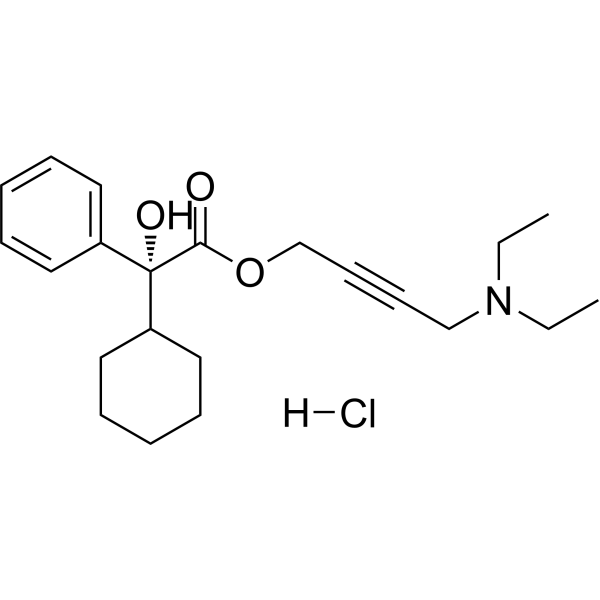(R)-α-Phenylcyclohexaneglycolic Acid 4-(Diethylamino)-2-butynyl Ester, Hydrochloride
Modify Date: 2025-08-25 17:59:08

(R)-α-Phenylcyclohexaneglycolic Acid 4-(Diethylamino)-2-butynyl Ester, Hydrochloride structure
|
Common Name | (R)-α-Phenylcyclohexaneglycolic Acid 4-(Diethylamino)-2-butynyl Ester, Hydrochloride | ||
|---|---|---|---|---|
| CAS Number | 1207344-05-5 | Molecular Weight | 393.95 | |
| Density | N/A | Boiling Point | N/A | |
| Molecular Formula | C22H32ClNO3 | Melting Point | N/A | |
| MSDS | N/A | Flash Point | N/A | |
Use of (R)-α-Phenylcyclohexaneglycolic Acid 4-(Diethylamino)-2-butynyl Ester, Hydrochloride(R)-Oxybutynin hydrochloride, a (R)-isomer of Oxybutynin hydrochloride, is an orally active muscarinic receptor antagonist. (R)-Oxybutynin hydrochloride has antimuscarinic, antispasmodic and anticholinergic activity, competitively antagonizes Carbachol-induced contractions. (R)-Oxybutynin hydrochloride can be used for researching incontinence due to neurogenic bladder dysfunction[1][2][3]. |
| Name | 0NX3818GCW |
|---|---|
| Synonym | More Synonyms |
| Description | (R)-Oxybutynin hydrochloride, a (R)-isomer of Oxybutynin hydrochloride, is an orally active muscarinic receptor antagonist. (R)-Oxybutynin hydrochloride has antimuscarinic, antispasmodic and anticholinergic activity, competitively antagonizes Carbachol-induced contractions. (R)-Oxybutynin hydrochloride can be used for researching incontinence due to neurogenic bladder dysfunction[1][2][3]. |
|---|---|
| Related Catalog | |
| References |
| Molecular Formula | C22H32ClNO3 |
|---|---|
| Molecular Weight | 393.95 |
| Exact Mass | 137.097122 |
| S547MDN7WX |
| 24II7HX270 |
| Ethanamine, N,N-diethyl-, hydrochloride (1:1) |
| EINECS 216-139-7 |
| JWB87T68BN |
| N,N-Diethylethanamine hydrochloride (1:1) |
| 0NX3818GCW |
| L9F3D9RENQ |
| Triethylammonium chloride |
| Triethylamine hydrochloride |
| MFCD00012500 |